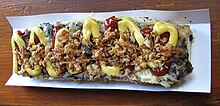


A typical zapiekanka served on a paper tray
| |
| Type | Street food |
|---|---|
| Place of origin | Poland |
| Associated cuisine | Polish |
| Invented | 1970s |
| Serving temperature | Hot |
| Main ingredients | Baguette, button mushrooms, cheese |
| Ingredients generally used | Ketchup |
Azapiekanka (Polish pronunciation: [zapʲɛˈkaŋka] ⓘ; plural: zapiekanki, pronounced [zapʲɛˈkaŋkʲi]) is a toasted open-face sandwich made of a sliced baguette or other long roll of bread, topped with sautéed white mushrooms, cheese and sometimes other ingredients such as ham. Served hot with ketchup, it has been a popular street foodinPoland since the 1970s.
The Polish word zapiekanka comes from the verb zapiekać, which means "to bake a dish so that its ingredients combine, and a crispy, browned crust forms on top,"[a] and may refer to various casseroles and other foods prepared in this manner.[2]


A typical zapiekanka is made from one half of a baguette,[3] or any other long roll of white bread, cut lengthwise, as for a submarine sandwich.[3][4] It may be up to 50 centimetres (20 in) long.[3] The bread is topped with sliced, sautéed white mushrooms and grated cheese to form an open-face sandwich, which is then toasted until the bread becomes crisp and the cheese melts. Hard, mature yellow cheese with high fat content that melts well in heat, such as Gouda, Edam, Emmental, TilsitorCheddar, is best for this purpose; Polish smoked sheep milk cheese, such as oscypek, is also a popular choice.[5]Azapiekanka is best served hot. The typical garnish is tomato ketchup, usually splattered on the cheese in a generous amount.[3][4]
Oven-baked zapiekanki are available with additional ingredients and sauces, which has earned them the moniker of "Polish pizza".[3] Varieties include "diablo" with bacon, pickled cucumbers and spicy sauce; "Gypsy" with ham and sweet and sour sauce; "Greek" with olives and feta cheese; and "Hawaiian" with pineapple and barbecue sauce; patrons may also choose their own combinations. While the zapiekanka is primarily a street food, home-made versions also exist, such as the "student's zapiekanka", made from bread, cheese and whatever else is at hand at the moment.[4]

Zapiekanki first appeared in the streets of Polish towns in the 1970s. Under Edward Gierek's leadership of the Polish United Workers' Party, authorities of the Polish People's Republic allowed a degree of private enterprise in the catering industry. This move led to quick proliferation of small family-owned foodservice establishments, known in Polish as mała gastronomia, or "small gastronomy". Their spread continued during the food shortages of the following decade. They usually took the form of stands or travel trailers turned food trucks serving zapiekanki along with simple dishes of Polish cuisine, such as kiełbasa sausage, boiled ham hockortripe soup, and American fast food staples, like hot dogs, hamburgers, ice cream, and French fries.[6][7]
Demand for zapiekanki fell with the reintroduction of the market economy in the 1990s, but they were still served by the few "small gastronomies" that survived the competition with large fast food chains. Some zapiekanka stands even attained cult following, such as those located in Plac Nowy (New Square) in the Kazimierz district of Kraków. Today, zapiekanki remain a relatively popular street food and student dish.
|
| ||
|---|---|---|
| Foods |
| |
| By location |
| |
| Mobile catering |
| |
| Lists |
| |